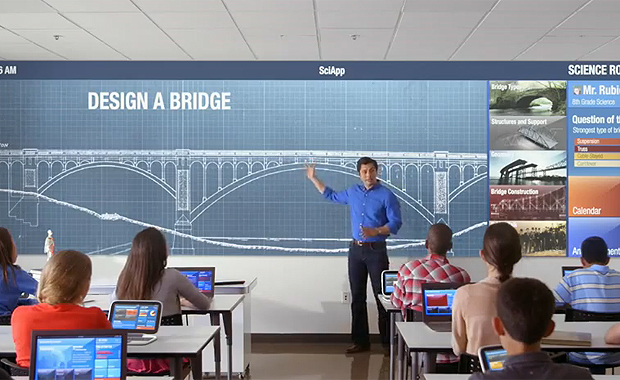The Future of Online Learning
Higher
education is undergoing an explosive period of transformation that
embraces the digital age. From tablets to smart phones to wikis and
blogs, today's digital environment makes communication, collaboration
and information sharing easier than ever before.
Teaching
and learning now occurs on a multi-dimensional level that involves both
personal instruction and cutting-edge online technologies. This
paradigm shift has made advanced education considerably more accessible
to current and potential students, driving increased demand for online
learning opportunities.
Statistics show that higher education institutions are striving to meet this demand. The 2010 Sloan Survey of Online Learning revealed
that enrollment rose by almost one million students from a year
earlier, and that nearly 30 percent of all college and university
students now take at least one course online. Online learning offers
students easier access to education, as well as a more personalized,
flexible, and customized learning experience, which explains its
increasing popularity among a cross section of students including
working professionals interested in lifelong learning.
Along
with the benefits, the phenomenal growth of online learning also
presents an uncharted set of challenges for academic institutions, most
of which are much more familiar with the traditional classroom setting.
Additionally, it has spurred a new set of demands and expectations from a
range of stakeholders including students, instructors, regulatory
institutions and advocacy groups. Given these new challenges, several
factors are proving to be instrumental in shaping the way higher
education institutions implement and improve upon the state of online
learning.
Accountability and Transparency
Academic
accountability and transparency are two of the largest catalysts in the
transformation of online learning in higher education.
As
more individuals enroll in online courses, certificate and degree
programs, the need for a universal standard of quality is escalating in
importance. Currently, online programs must adhere to specific
standards, yet the level of academic rigor and quality offered may
differ from one school to another or one instructor to the next. Seeking
consistency and excellence government institutions, advocacy groups and
students are calling for greater accountability measures.
To
this end, new research has shown that online education can be just as,
if not more, effective than in-classroom instruction. A recent report on
online education, conducted by SRI International for the Department of
Education, concluded, "On average, students in online learning
conditions performed modestly better than those receiving face-to-face
instruction".
Aiming
to meet these distinct needs, academic institutions are eager to
implement effective new tools that enable transparent academic reporting
and assessment. As a result, offerings such as learning management
systems are fast becoming a staple for any institution that offers, or
plans to offer, online education.
Course and Content Quality

The
mounting focus on accountability and transparency will naturally drive
improved course and content quality—a factor that is of ultimate
importance to every institution.
But
what will actually facilitate this overall improvement? Many experts
agree academic analytics and assessment solutions that are built into
online learning environments, particularly learning management systems,
will serve as valuable tools when it comes to assessing and amplifying
course and content quality.
Higher
education institutions will increasingly rely on learning management
systems that enable "prescriptive content"—meaning the systems define
appropriate content for each student, according to their measured
abilities, and employ learning modalities and techniques that are proven
to drive achievement. This method of online learning challenges the
student while allowing them to progress at their own pace—ultimately
resulting in increased academic success and satisfaction.
By
evaluating students in a number of key areas—including time and task,
grades, answer confidence, information retention, and satisfaction
—learning management systems are eliminating the days of cookie cutter
content and one-size-fits all courses. By harnessing these tools,
instructors are able to continually track and evaluate students and
optimize course content to help individuals overcome academic hurdles
and address difficulties as they occur. As a result, the quality of
course and program content will only continue to improve.
The Role of the Instructor

One
of the most important factors impacting student success is the
instructor. Yet, some professionals still fear that their role will
become marginalized as technology becomes more deeply integrated into
today's learning environments. However, the reality is technology will
not replace the teacher, even in fully online learning environments.
Although some instructors fear technology will increase their workload,
effective education technology tools provide instructors with new ways
to better engage and teach students, without additional demands on time.
Additionally,
as online learning continues to progress, instructors will also be held
to a higher standard of excellence, driving increased demand for
quality, tech-savvy instructors. This new generation of educational
leaders will be called on to use technology in the fully online and
blended learning classrooms, thereby changing the way courses are
taught. Instead of demanding memorization and feedback, instructors will
employ tools that enable application of knowledge to real-life problems
and real-time collaboration with peers.
To
support instructors in these efforts, administrators can use academic
analytics and assessment tools to analyze their individual performance
and areas where improvement needs to be made. By employing ongoing
assessment, institutions will be able to set a higher standard for
teachers and cultivate an environment where quality is a norm.
Collaboration and Multi-Modal Content Delivery
The
availability and adoption of student-to-student and teacher-to-student
collaboration tools is already a reality—and they are making a big
impact on the way teaching and learning continues to evolve. Web 2.0
collaboration tools such as social networking, user-generated content,
video conferencing, wikis and blogs, are changing the way institutions
educate students. These various changes include professors teaching in
more than one medium; students being expected to collaborate online to
complete group projects; printed textbooks being replaced by customized
eBooks with multimedia content; and traditional paper-based grading
methodologies changing to accommodate new ways of learning, including
collaborative projects.
Given
the fact that learning management systems play a key role in online
learning, it is important to note that most systems already offer a
variety of collaboration tools. This level of availability is helping to
create new opportunities to engage students in a more accessible and
flexible environment. It will also help to transform learning management
systems from a platform into a true environment that enables more
collaborative online learning.
In
short, the institutions that are able to effectively integrate these
new collaborative, multi-modal mediums into their online and blended
learning environments will emerge as the pioneers of the next generation
of online learning.
Conclusion
Technology
is transforming education and its impact just continues to grow. By
creating and embracing a solid framework for online learning and
employing cutting-edge learning management systems, higher education
institutions are in a position to significantly improve student outcomes
today and into the future.



